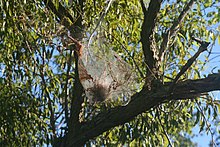American weaver
| American weaver | ||||||||||||
|---|---|---|---|---|---|---|---|---|---|---|---|---|

American weaver ( Hyphantria cunea ) |
||||||||||||
| Systematics | ||||||||||||
|
||||||||||||
| Scientific name | ||||||||||||
| Hyphantria cunea | ||||||||||||
| ( Drury , 1773) |

The American weaver ( Hyphantria cunea ), sometimes also called the white bear moth , is a butterfly ( moth ) from the subfamily of the bear moth (Arctiinae).
features
butterfly
The moths have a wingspan of 24 to 34 millimeters for the males and 29 to 38 millimeters for the females. The upper side of the fore wing is snow-white in color. In some specimens, more or less small black dots or narrow stripes stand out on it. The apex is pointed. The upper side of the hind wing is also white. The thorax and abdomen are also colored white and covered with silky hair. The antennae of the males are ciliate on both sides, those of the females are thread-like and slightly sawtooth. The proboscis is stunted.
Caterpillar
Young caterpillars are thinly haired, yellowish in color and have dark warts on each segment. In fully grown caterpillars, the hairs are long and bushy. They have a greenish-yellow basic color as well as dark back and side back lines. The warts are black on the back and orange-yellow on the sides. The tufts of hair are made up of a combination of reddish, white, and black hair. The head is glossy black.
Similar species
The broad-winged speckled body ( Spilosoma lubricipeda ) and the narrow-winged spotted body ( Spilosoma urticae ) differ in their yellow, black-dotted body. The white colored moths of the gray bear ( Diaphora mendica ) also differ by their black dotted body. The poplar moth ( Leucoma salicis ) is significantly larger. The females of the reed brush moth ( Laelia coenosa ) differ in their yellow legs. Goldafter ( Euproctis chrysorrhoea ) and swan ( Euproctis similis ) differ in their yellow-brown anal bush. All of the aforementioned species also have wider fore wings and a rounded apex.
Distribution and occurrence
The species was initially only native to North America and Mexico , but was introduced into many areas of Europe and Asia via international trade. In 1940 moths were found near Budapest . Since then, the species has continued to spread. It prefers to colonize flat or slightly hilly landscapes.
Way of life
The time of flight of the moths varies depending on the climatic conditions of the area where they are found. One to four generations can occur per year. In Europe, two generations are usually formed per year, whose moths fly from April to June and then again in late summer. They are nocturnal and visit artificial light sources . After mating, the females lay up to 500 eggs on leaves. The young caterpillars initially live gregariously in spun nests. Due to their large number, they occur in areas as feared agricultural pests , as they bare trees in orchards or entire forests. Although some of the caterpillars are attacked by parasites or eaten by birds, their harmful effects cannot be contained. In the USA , various insecticides are therefore used to combat young caterpillars, including carbaryl (Sevin) and acephate (Orthene). Adult caterpillars live individually. They feed polyphagously on the leaves of a wide variety of host plants, including: deciduous trees, fruit trees, shrubs, bushes, ornamental plants, vegetables and low-growing plants. 250 different food plants have already been identified. Since the caterpillars' appetite persists until autumn (English: fall ) and the leaves of the mulberry tree ( Morus ) (English: mulberry ) are also eaten, the species is referred to in English as Fall Webworm or Mulberry Moth . Pupation takes place in a cocoon in various hidden and protected places. The pupa hibernates.
swell
Individual evidence
- ^ A b Josef J. de Freina, Thomas J. Witt: Noctuoidea, Sphingoidea, Geometroidea, Bombycoidea. In: The Bombyces and Sphinges of the Western Palaearctic. 1st edition. 1, EFW Edition Research & Science, Munich 1987, ISBN 3-926285-00-1 , p. 151/152
- ↑ Walter Forster , Theodor A. Wohlfahrt : The butterflies of Central Europe. Volume 3: Weirdos and Swarmers. (Bombyces and Sphinges). Franckh'sche Verlagshandlung, Stuttgart 1960, DNB 456642196 , pp. 35-36.
- ↑ Webworm Treatment: Tips For Controlling Webworms
literature
- Josef J. de Freina, Thomas J. Witt: Noctuoidea, Sphingoidea, Geometroidea, Bombycoidea. In: The Bombyces and Sphinges of the Western Palaearctic. 1st edition. 1, EFW Edition Research & Science, Munich 1987, ISBN 3-926285-00-1 , p. 151/152
Web links
- Lepiforum e. V. - Taxonomy and photos
- pyrgus.de - Butterflies and their ecology
- arbofux.de - Diagnostic database for trees
- cabi.org - Mulberry Moth
- funet.fi - dissemination
- Hyphantria cunea in Fauna Europaea. Retrieved November 14, 2015


